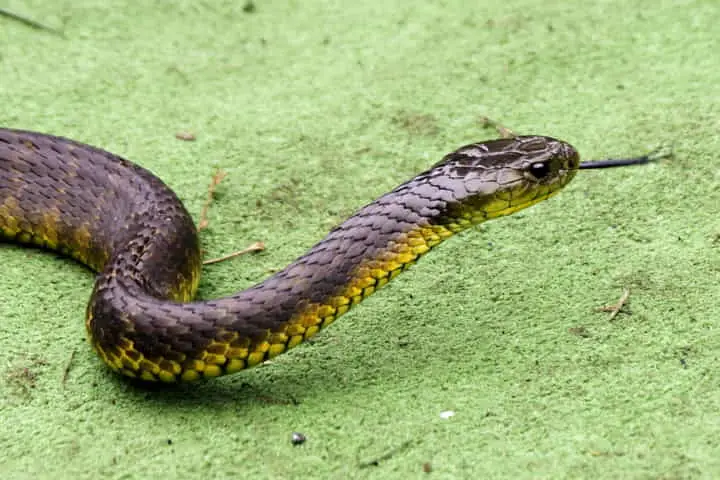

Australian Tiger snake whose ancestors had come to the continent by sea (Pic. Courtesy Twitter/@GregBourke3)
<p>
<strong>In a recent study done by the scientists of the University of Adelaide it was found that forebears of some of Australia&rsquo;s poisonous snakes had come to the continent not by land but by sea, as per a sciencedaily.com report.</strong></p>
<p>
The study which was published in the journal Genes, mentions that the scientists examined the genomes of two front fanged snakes or elapids of the continent &ndash; a brown and a tiger snake — and this was studied and compared with the marine and semi-marine elapid sea snakes and elapids from Asia.</p>
<p>
This comparison helped the researchers to deduce that the ancestor of all elapids of Australia had collected self-mobilising or jumping genes and self-replicating genes and these were not there in their relatives that were land based. Instead, they came from entirely another source.</p>
<p>
Highlighting this point, the study&rsquo;s corresponding author Professor David Adelson said: <a href="https://www.sciencedaily.com/releases/2022/02/220210154140.htm">&quot;While we know all marine and semi-marine</a> sea snakes descended from a common Australian land-based ancestor, the origin of Australian elapids has been debated for some time. Some believe their ancestors travelled by land, whereas others hold the more contentious view that a marine or semi-marine ancestor swam here.&rdquo;</p>
<p>
<img alt="" src="https://www.indianarrative.com/upload/news/Australian_Brown_Snake1_Twitter_KateBosko.webp" style="width: 720px; height: 480px;" /></p>
<p>
<em>Brown snake (Pic. Courtesy Twitter/@KateBosko)</em></p>
<p>
Sharing more details, Adelson who is from School of Biological Sciences, University of Adelaide, added: &ldquo;In our research we found a number of genes that were present in the ancestor of all Australian elapids but could not be traced to a snake ancestor; instead they could be traced to similar transposable gene sequences found in marine life, including fish, sea squirts, sea urchins, bivalves, and turtles. This indicates the marine environment transferred the new genetic material into the snakes and offers new support to the argument that the first Australian elapids swam to our shores. They must have previously acquired the new genetic material during an ancestral period when they were adapted to marine life.&quot;</p>
<p>
<strong>Also read: <a href="https://www.indianarrative.com/science-news/hidden-for-years-this-wide-eyed-boa-finally-comes-under-the-human-scanner-115506.html">Hidden For 133 Years this wide-eyed Boa Finally comes under the Human Scanner</a></strong></p>
<p>
Further the scientists were able to point out 14 separate transfer events of the new genetic material from other marine organisms. Of these eight genes were uniquely present in the genomes of marine and semi-marine sea snakes. The acquired genes in the semi-marine snake genome ranged from eight to 12 per cent of the total genome sequence.</p>
<p>
Delving on this, Professor Adelson observed: &quot;This meant that we could unambiguously determine the major genetic differences between land and marine/semi-marine snakes were a consequence of migration into a marine environment. This is the first time that jumping genes have been used to confirm the evolutionary history of any animal species, and this research definitively proved that the common ancestor of all Australian elapids adapted to a marine environment. It may also have made it easier for the subsequent land to marine transition of sea snakes.&quot;</p>
Australia's High Commissioner to India, Philip Green OAM, called Yoga one of India's gifts to…
The Bharat Sanchar Nigam Limited (BSNL) has announced the soft launch of BSNL Quantum 5G…
The Indian Embassy in Iran has said that the embassy will make efforts to evacuate…
India's gross direct tax collections for the financial year 2025-26 rose by 4.86 per cent…
Russian President Vladimir Putin has said that Moscow is not seeking Ukraine's unconditional surrender, but…
Extending his greetings on the 11th International Day of Yoga, Lok Sabha speaker Om Birla…